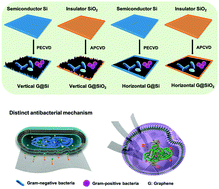Distinct antibacterial activity of a vertically aligned graphene coating against Gram-positive and Gram-negative bacteria†
Abstract
Graphene-based nanomaterials (GBNs) are known to exhibit biocidal activities, however, the combined effect of GBNs based on physical disruption and oxidative stress on different types of bacteria remain unclear. Here, we use both Gram-negative (Escherichia coli and Salmonella typhimurium) and Gram-positive (Staphylococcus aureus and Staphylococcus epidermidis) bacteria to investigate the antimicrobial properties of vertically and horizontally aligned graphenes grown on semiconductor silicon (Si) and insulator silicon dioxide (SiO2). It is found that the bacteria show different sensitivity to isomeric–structured GBNs. Gram-negative bacteria are more vulnerable to graphene-coated Si substrates than to SiO2, because the less negatively charged membrane enhances the electron transfer effect that extracts the electrons from the microbial membranes, and Gram-positive bacteria seem to show more susceptibility to physical puncturing of vertically aligned graphene than to horizontally aligned graphene due to the nature of the compound and the shape of the membrane structure. Subsequently, the vertically aligned graphene Si substrate (G@V-Si) exerts the superior antimicrobial ability on all the bacteria. Finally, all the above GBNs show low cytotoxicity and high biocompatibility, and the robust in vivo antibacterial effect indicates that G@V-Si could serve as an ideal platform for antimicrobial treatment.



 Please wait while we load your content...
Please wait while we load your content...